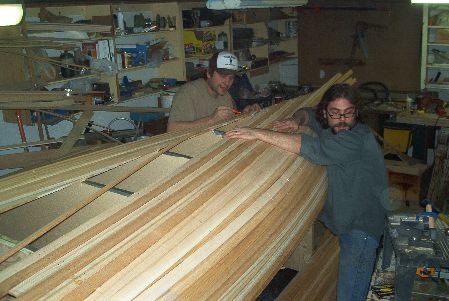
This year (2006), we participated in the Yukon River Quest race in late June. This race is for canoes and kayaks and goes from Whitehorse to Dawson City on the Yukon river – its about 740 km. The race is not staged; you go straight from Whitehorse to Dawson City with 2 mandatory stops. The first stop is for 7 hours at Carmacks; you get to Carmacks after just under half the paddling. The second is for 3 hours at Kirkman Creek after 2/3 of the remaining paddling. Teams complete the race in 40 to 70 hours of paddling.
Our team, Team Kisseynew Dalutweh Denesuline, was lead by Martin Bernardin from Saskatoon, Saskatchewan. Martin had put a lot of work into preparing for the race including building the canoe (the previous year), buying a trailer for the canoe, buying a van for the trip and paying the entry fee before having a full team. The year before Martin had built a cedar strip voyageur canoe for the Saskatchewan Centennial Canoe Quest race. The canoe is just under 26 feet long and 48 inches wide and weighs about 230 lbs. He worked on the canoe when ever he wasn't at his job (or, more accurately, he went to his job when he wasn't building the canoe) from February through May of 2005. Because Martin's garage was not big enough, he had to build the canoe in two pieces and then bolt and fiber glass them together.

Martin (on the left) and Matty building the canoe
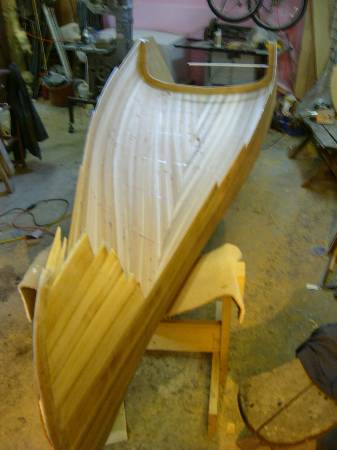
Half a canoe
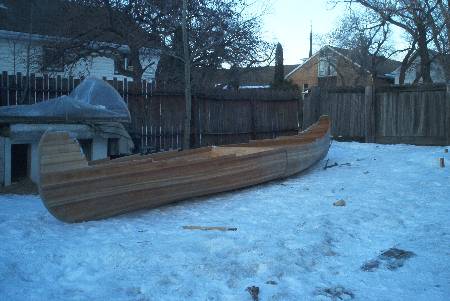
Whole canoe pieced together
The Saskatchewan Centennial Canoe Quest race was a staged race across northern Saskatchewan to celebrate Saskatchewan's 100th anniversary. Most days the race ended in a town and you were allowed to change the paddlers – the canoes had 6 paddlers in them and you could have 12 people on your team. We approached the race thinking we would be a recreational team – we would enjoy the scenery and paddle along as best we could. We discussed how many and how long the breaks would be. However once the race started we became very competitive – we only took breaks long enough to swallow some water or grab a bite of food. We did pretty well considering our technique wasn't very good. We finished 9th out of 30 teams mainly because we had the fastest canoe.
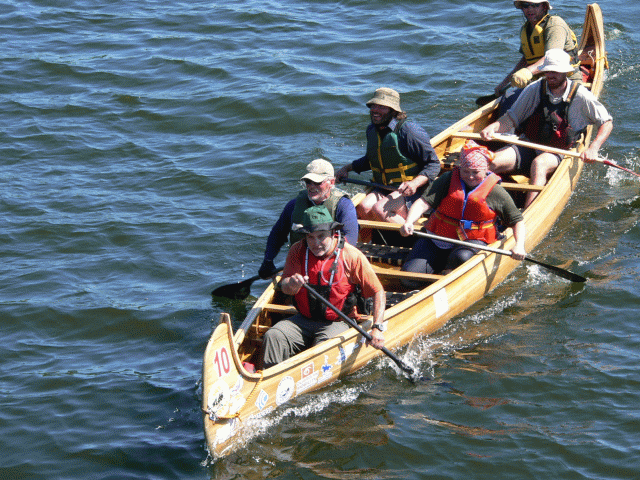
Team Kisseynew in Saskatchewan Centennial Canoe Quest
All the other teams had purchased or rented their canoes and their designs were all very similar to each other. Martin, on the other hand, had designed his own canoe. The bow and stern of the other canoes were much more blunt than Martin's; Martin's canoe left much less wake. Martin's canoe also had a flatter bottom than the other canoes and was more stable. So Martin had designed a canoe that was both faster and more stable – amazing.
For the Yukon River Quest race, organizing the team was an adventure in itself. First of all the Yukon River Quest race committee required at least 8 people in a voyageur canoe (the canoe was really designed for 6). Originally there were to be 5 people from Lac Brochet and the remainder from where ever. However, the people from Lac Brochet needed to get funding from their local government – it cost hundreds of dollars for them to just to get to Saskatoon since they had to first fly to Thompson, Manitoba.
Martin's connection to Lac Brochet was through Gordon Moise. Gordon has been living mostly in Saskatoon for a few years because his girl friend is on kidney dialysis. Martin met Gordon during the Saskatchewan Centennial Canoe Quest; Gordon was on the team from Hatchet Lake (which is close to Lac Brochet).
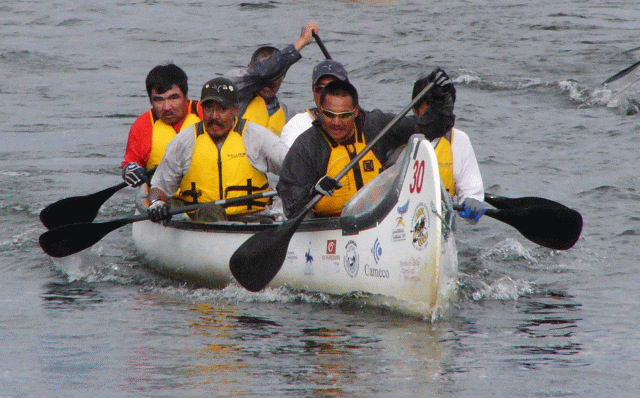
Gordon in the bow in Saskatchewan Centennial Canoe Quest
Martin had asked a number of people from his team for the Saskatchewan race to join the team for the Yukon race. Martin's brother Michael, Ken Wallis and myself, Brent Clark, all joined. Michael is from Edmonton, Ken farms a couple of hours west of Saskatoon, and I am from Saskatoon. If you look back at Team Kisseynew picture, I'm in the bow, Ken is right behind me and Martin is in the stern.
A few months before the race, the team consisted just of Martin, Michael, Gordon, Ken and myself. Gordon was phoning back home a couple of times a week to try to arrange funding for people from Lac Brochet. There was interest but no commitment. When there was only several weeks left before the race, Martin decided that there would be 8 people on the team and started looking for 3 more people. Michael had talked to his friend Ryan Martin from Whitehorse and Ryan was very interested. He paid his money and he was in. Finally Martin decided he couldn't wait any longer and told Gordon to get 2 people from Lac Brochet. Paul Tssessaze and Chris Denechezhe arrived in Saskatoon a few weeks before the race.
We starting training in late April after the ice came off the South Saskatchewan River. At first there was just Martin and me since everyone else was out of town – we practiced in a tandem canoe. On the weekends Ken would drive in and we would get a couple more people and practice in the voyageur canoe. We had read somewhere that you should practice for 250 hours; we tried for at least 10 hours a week, which would total about 100 hours.
With respect to fitness we were much better off than we had been the year before. Surprisingly, at least to me, we still had muscle from the year before. The first time this year that we paddled for more than 5 hours, I was just a little sore the next day. The previous year I couldn't lift my arms for several days. Technique wise we were also much improved. The previous year we were still learning the marathon stroke during the race – we were all recreational paddlers before the race. This year we had the basics of the stroke down and we had Gordon in the bow to demonstrate the stroke; Gordon is a very strong paddler.
About 3 weeks before the race, we did a 90 km run from Outlook to Saskatoon. Michael drove down from Edmonton and Ken met us in Outlook. Katherine Peterson also joined us. Katherine was on our Saskatchewan Centennial Canoe Quest team the year before and was paddling the Yukon race in a tandem canoe. We paddled hard for 8 ½ hours in the rain. At the end we were all tired, cold and wet but our bodies mostly felt pretty good. While paddling Michael had a lot of pain in his back just below his neck. He was quite nervous about paddling for 50 hours in that kind of pain.
We left for Whitehorse the Friday before the race – the race started at 12:30 in the afternoon the following Wednesday. There were 7 of us in a van: Martin, Ken, myself, Gordon, Paul, Chris and Martin's dad Ron. Ron had decided a couple of days before to be our support crew and it was a good thing too. Martin had earlier arranged for the sister of an old girl friend who lived in Whitehorse to be our support crew, but wasn't able to get a hold of her before the race. We never did find her. If Ron hadn't come along, things would have been much more complicated. Ron is also a registered massage therapist; a big added plus. Michael was flying from Edmonton to Whitehorse and Ryan lived there.
We drove up in a used Chevy van with a diesel engine. Martin had just purchased the van a few months before. We had used a similar but older van with a gasoline engine the year before for the Saskatchewan race but mechanically it was in rough shape. This years van was in better shape and got much better mileage - at 10 miles to the gallon we had estimated the trip would cost at least $2000 in fuel alone. If the new van got 20 miles to the gallon that would save $1000 on this one trip. Martin had also had a trailer made for the canoe. It was as long as the canoe so it didn't put stress on the canoe during the drive. We put most of our gear in the canoe and tarped the canoe over. There was room in the van for one person to lie down in the back. The picture was taken near Gordon's duplex and the people in the picture are, going left to right, Paul, Chris, Gordon, Martin and myself.
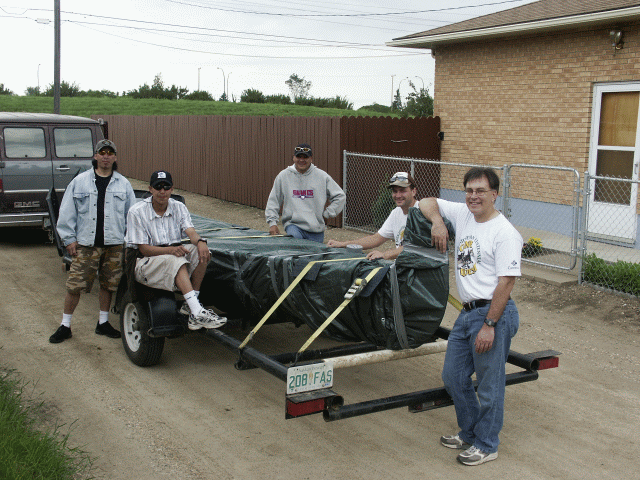
Canoe and trailer before the long drive up
The drive up took 30 hours. We only stopped to fuel up; no stopping for meals. You just grabbed a sandwich from the gas station - this was Martin's idea and he enforced it ruthlessly. Ron was still complaining a few days later about not being able to stop for bacon and eggs for breakfast. We took turns driving, although Martin drove more than anyone else. The person lying down in the back was supposed to sleep, although I had a tough time sleeping there. I had the 1 am through 6 am shift. During my shift, Ron put on a cassette tape of Nana Mouskouri. The music was faded to the back for some reason where Martin was trying to sleep. After a minute or two of her whining voice, Martin suddenly sat up and said “What the fuck is that? Are you trying to make me jump out of the van?”.
When we stopped at 6 am for diesel, everyone got up and was feeling pretty bad. I was thinking if I feel this bad driving how am I going to be able paddle through the night? Ken drove after me and quickly was having trouble staying awake - he was using the entire highway. Martin asked me if I could drive again – I said yes even though I hadn't really slept in 24 hours. I started yammering at Ken and that was enough to wake him up. Martin noted that my irritating habit of talking too much finally was useful.
Several hours out of Whitehorse, we saw Katherine Peterson and her canoing partner Joe. They had spent several days driving up. We joked that if your time in driving up was indicative of the time it took to finish the race, then we would kick their ass.
We arrived in Whitehorse around 4 o'clock in the afternoon and drove around in a fairly confused state. We decided to call Michael; he had flown up the night before and was staying at a friends house. Ron called directory assistance on his cell phone but we didn't have a pen to write down the number and after Ron told everyone the number, none of us could remember it. We weren't exactly firing on all cylinders.
We stopped to think about what to do and Ryan happened by. He saw the canoe and the Saskatchewan license plates and figured it must be us. He was surprised to see us (he thought we would take another day to get there). He was on his way out to dinner with his wife but would call us later. A couple of minutes later an RCMP officer stopped. He was on the RCMP voyageur team and talked to us about the race. He told us they had only practiced a couple of times and their canoe weighted 600 lbs. They seemed to be treating the race as more of a painfully fun adventure than a race. He even drove me around to show me where they practiced; he was very helpful.
We ended up staying at a campground just outside of town. There were lots of other racers staying there including a couple of British kayakers in the site next to us. We set up the tents and relaxed. After a while Michael and then Ryan showed up. In the picture below. Ryan is on the the left end of the semi-circle and Micheal on the right. Ryan is modeling the uniquely Yukon wardrobe of a shorts and a toque.I went to bed pretty early - I wanted to catch up on sleep before the race when we would have to stay up for 2 or 3 days.
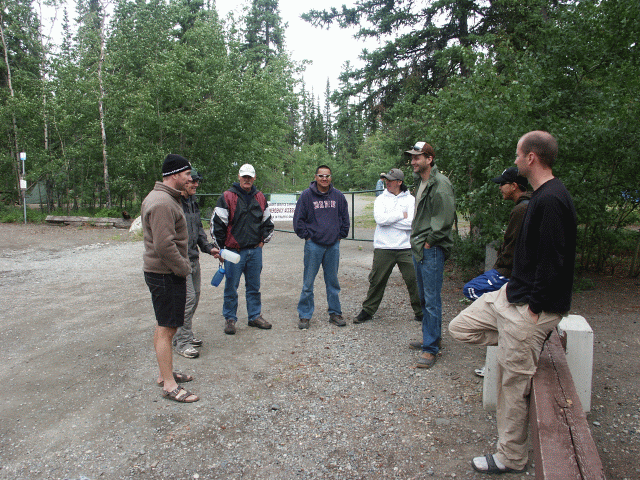
Whitehorse campground
Over Sunday, Monday and Tuesday we spent a few hours practicing and then getting the canoe ready for the race. Sunday was the first time we had our entire team together in the canoe and the first time anyone else had seen Ryan paddle. It was pretty obvious that Ryan hadn't really been shown the marathon stroke (although I'm no expert as Martin likes to point out). He was trying hard but you can only learn so much in a couple of weeks. Even more importantly you can only develop so much muscle in a couple of weeks.
Martin organized the canoe with: Gordon in the bow; then Ken; then myself and Ryan sharing a seat; then Michael and Chris sharing a seat; then Paul and then Martin in the stern. Gordon was in the bow because he was the strongest paddler and would set the pace. Martin was in the stern because this is the most important position and he felt he needed to take on this responsibility. The stern person steers the boat and picking a course on a river like the Yukon can speed or slow the canoe by kilometers per hour. Paul was second last in the canoe so he could replace Martin in the stern if necessary. The rest of us were placed to balance the canoe. Ryan and I are both around 190 lbs. Chris was the lightest at 140 lbs and Michael is 160 so they had the biggest difference between them. Balancing the canoe both front to back and side to side is very important since if it out of balance either way it is hard to steer.
We practiced our switching as well. With 6 people in the canoe we switch every 30 strokes. To switch you simply grab the other gunwale and pull your self across. With 8 people in the canoe and 2 people in 2 of the seats, switching was more complicated. In the shared seats, one person went over and the other went under. When sliding across you only lose 1 or 2 strokes. When going over and under you lose 3 or more. We also decided how often we should switch. We felt 30 was too quick with people going over and under, so we tried 50. That seemed to work pretty well. We also didn't all switch at the same time. First all the people in a seat by themselves switched, then Ryan and I switched and then Michael and Chris switched. I counted to 50 and called the switch.
We had a GPS and kept track of our speed. I had done some computations based on times from previous years. If we could do more than 17 kph we would be among the leaders. In our trial runs we were doing over 17 without paddling very hard, so we were pretty confident. However the river was at peak because it had been a late spring so we wondered if everyone would just be faster this year.
A couple of interesting things occurred in the camp ground. The guys from up north had brought frozen caribou meat to eat while we camped. They had brought too much, so once it thawed they needed to do something with it to keep it from spoiling. They ended up cutting it into strips, making a rack and drying it over the fire to make jerky as you can see below. The tarp keeps the smoke and heat in.
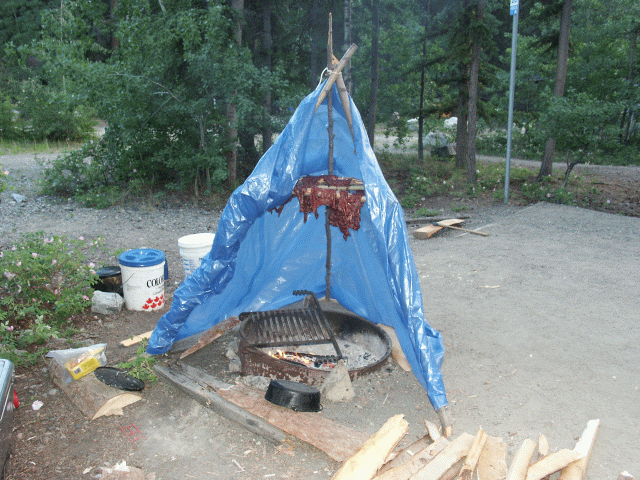
Drying caribou meat to make jerky
The guys from up north also started playing the hand game. This is a guessing game where one person places a small rock in one hand and the other person guesses which hand the rock is in or which hand is empty. You can play with teams; everyone on one team puts their hands out and someone on the other team guesses. They said they play in tournaments for thousands of dollars. We all tried playing one night but most of us amateurs were too tired for strategy. Our guesses and where we hid the rock were pretty much random. Below Martin is making someone from my team of myself, Chris and Michael guess.
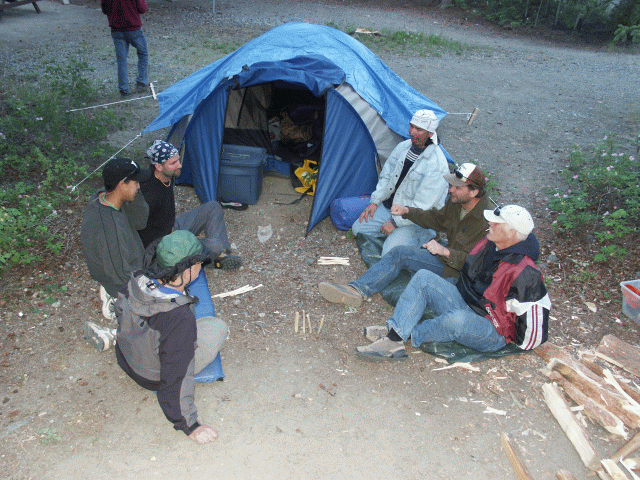
Hand game
On Tuesday we had to take our canoe to the Whitehorse visitor center for measurements and to have our gear checked out. The canoe had to be at least 46” wide. Each of us needed a life jacket. a sleeping bag and various other gear. As you can see from the picture below we had duct taped blue foam to the gunwales so we wouldn't get bruised hitting them. After the race the consensus was that wasn't worth the bother except in the stern. There was blue foam across the bow to keep the water off Gordon in big waves. We had also added blue foam that went right over Martin's lap. He put the maps and the GPS on this and it also kept the rain off.
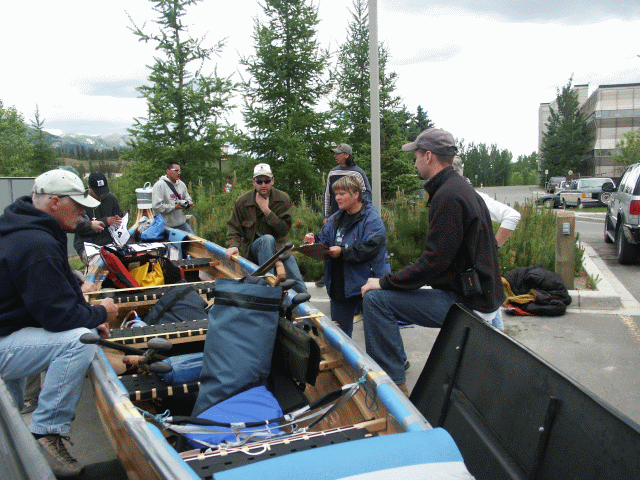
Canoe gets checked out
Lots of people came by and looked at our canoe. They were very impressed particularly when they found out that Martin had built it.
We talked to Katherine about how things were going. She said she had put quite a bit of effort in finding a way that she could pee in the canoe and practicing this. I thought that was kind of funny since peeing seemed like the least of our worries.
On Tuesday everyone started having gear, food and body anxiety. For example, a bunch of people went out and bought rubber boots to wear in the canoe; they wanted to keep their feet dry. People began packing a lot of food; the guys from up north made sandwich after sandwich. Everyone wondered whether they should treat the water or just drink out of the river. I bought iodine tablets but never used them. My shoulder seemed sore and I was worried it fail me during the race (although in the race I didn't even notice it). Michael was worried his neck would kill him (although it didn't bother him either).
The race started at 12:30 on Wednesday. We had to have our canoe in place on the bank of the river by 11 am. At 9:30 we hadn't broken camp yet and Chris and Paul weren't up yet. Martin arrived at the tents after sleeping in the van. He was ready to go and quickly got everyone moving. We made it to the river bank with minutes to spare.
The weather on Wednesday was pretty crappy – its drizzled all day. All the other days in Whitehorse were pretty nice although it had drizzled Saturday morning. Whitehorse is in a semi-arid area so it doesn't rain very often. Except on the day that the race began.
We got to the race start at 12:00 and stood around in the rain while they announced each team. Very exciting. You can see in the picture below that Ryan and Michael are wearing hiking boats. With all the rain, their feet still got wet.
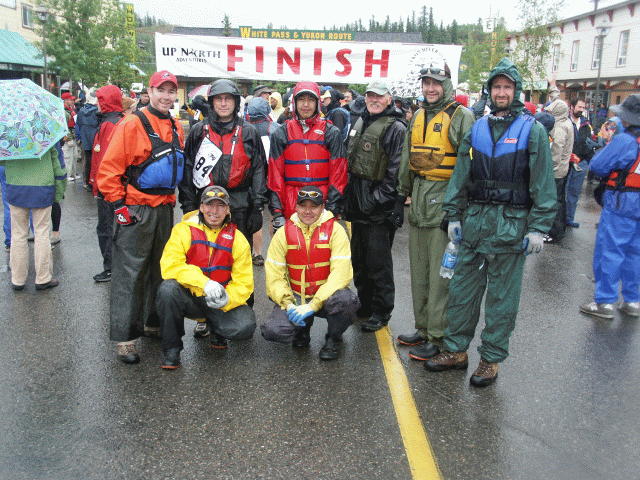
Race Start Line
Finally at 12:30 the race began. We first ran from the middle of the town to our canoe. I ran beside Martin with everyone else on the team ahead of us. Martin didn't enjoy the run much; he had been training for paddling not running. I had been doing some running to improve my cardio so it didn't bother me much. The way the canoes and kayaks were parked, we got to our canoe first and we paddling down the river first. We were leading. Amazing.
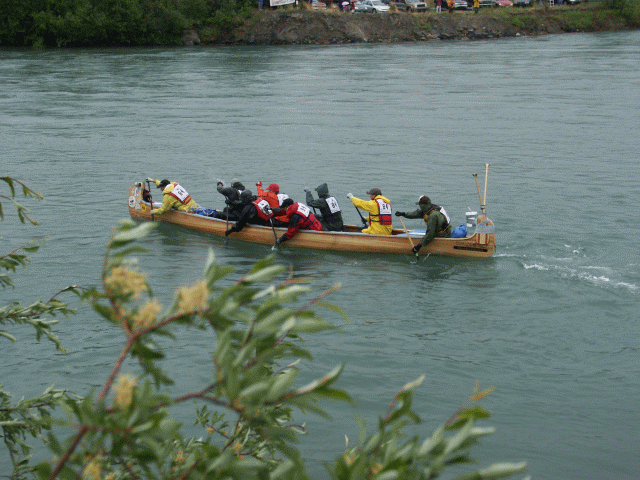
Early lead at the start of the race
Unfortunately after a few kilometers, Martin took a side channel that is normally dry. The river slowed quite a bit in our side channel and quite a few teams got ahead of us before we got back to the main channel.
Quickly we started catching and passing other teams. We weren't paddling full out – I think our stroke rate was about 54 and our sustainable max is in the low 60's. Things felt pretty good. One of the first teams we passed was another voyageur canoe. They seemed to have a pretty strong team, but we went by them pretty easily. Next we came up on a group of kayaks and a canoe. The canoe was paddled by Steve Landick and Gregg Nelson; Steve has won the race a couple of times and finished top 5 other times.One of the kayaks was paddled by Stephen Mooney in a one person kayak; Stephen had been on one of the winning teams in the year before. Looking ahead of this group there was only two 2 person kayaks ahead. Amazing enough we came up on the group fairly quickly and passed them. As we passed them, the canoes and kayaks jumped on our wake. Although our wake is small compared to other voyageur canoes, it is huge compared a tandem canoe or kayak. Before we passed them, none of the kayaks or the canoe had been gaining on the second kayak. We were gaining on the second kayak and, as they rode our wake, so were they. However we were going too fast for most of them to stay on. One single person kayak managed to ride it for half an hour; I believe this was Carter Johnson who finished third over all, but eventually he fell off too. By the time we got to Lake Laberge, which was after about 3 hours, we had only 2 kayaks ahead of us and we were gaining on the kayak in second. The one in first seemed to be pulling away.
Lake Laberge is a long (about 50 km) narrow lake. Many of the racers were worried about it but we had gone through much bigger lakes in the race in Saskatchewan in the previous year. There was a strong tail wind and Martin announced that the GPS said we were doing 11 kph. The waves were large enough that you had to be careful when you switched. I was forced to wait for a calm moment before I called a switch. Also Ryan and I screwed up a few switches when one of us put their weight too much on one side before the other person had moved over. Martin was not happy and yelled something like “Fuck, you guys - don't tip us into the lake”.
We slowly gained on the kayak as we crossed the lake. Near the end of the lake the person in the stern of the kayak stopped paddling to pump out the kayak. When this happened, we quickly passed them. That was one of our big advantages. If one of us stopped paddling to eat or pee, we only lost 1/8th of our power; if one person stopped in a tandem boat, they lost half their power.
While paddling across the lake most of us had stopped paddling to pee. You kneeled down and peed into a plastic jug that we all referred to as the piss bucket. It isn't that easy with all the layers of clothes and while wearing gloves. Also in the cold weather, shrinkage was definitely an issue. I found I had to take off one glove.
After we crossed the lake, we came to a check point. We all yelled out our canoe number - “84”. We asked how far we were behind the lead kayak. At first we thought they said 14 minutes but then we heard it correctly: 40 minutes. This really discouraged us – the guys in front of us were machines.
Chris asked if we could stop so he could pee. He had tried repeatedly to pee in the canoe but had a nervous bladder. None of the guys from up north had peed yet (this was over 8 hours into the race), but everyone else had. Martin reluctantly agreed to stop and everyone got out and peed. Before we were back in the boat, we saw the kayak we had passed on Laberge coming up fast. After we got back in, Martin said “No more stopping the canoe to pee”. I had not imagined that peeing in the canoe would cause a problem, but Katherine had been right, we should of practiced it. We could not afford to stop every couple of hours for a pee break.
Once we had hit the river, calling the switches was a lot easier; I just counted to 50 and called a switch. We didn't switch when someone was peeing since it was a bit tough to pee and switch at the same time. I usually kept counting and sometimes we were 200 strokes on one side. After 100, you were dying for a switch. Some of the other voyageur teams paddled for half on hour on one side (at 40 strokes a minute that would be 1200 strokes). We would have had a mutiny if we had remained on one side for that long.
Other than paddling, the other things we were supposed to be doing were eating and drinking. Because it was cool (about 8 degrees C) and raining, we didn't need to drink that much. I think I drank about 1 liter every 4 hours of paddling. I also wasn't eating that much food. Over the first day and night, I ate a couple of bagel sandwiches, one power bar and some sliced up apples. I had brought a bunch of power bars but I could barely get the first one down; it tasted like I had a mouth full of ashes. I wasn't eating enough to replace the energy I was burning; instead I was consuming my fat (which I have plenty of).
It continued to drizzle rain on us on and off. Everyone was pretty wet and cold. Michael talked about changing clothes, but I told him to wait until it stopped raining. At about 1 am, a thunderstorm came through. It absolutely poured rain on us. We later learned it rained 1” in an hour. Some other teams got hailed on. Everyone was now drenched. Chris's rain gear hadn't worked very well and he was very wet and cold. He tried eating some chocolate covered coffee beans to perk himself up, but all it did was make him throw up. Michael kept encouraging him and, even though he was really suffering, Chris kept paddling. It was the only way to generate body heat so he didn't go into hypothermia.
Ken was also suffering; his body was trying to shut down for the night. He was having a hard time forcing himself to paddle hard. By 3 am it had stopped raining and everyone was cold. Ken announced he needed to put on dry clothes to warm up or he would be useless. He changed his shirts and put on a toque. In turn, Ryan, myself, Michael and Chris did the same. When I pulled off my wet shirts, Michael exclaimed “Holy shit. Why do you even need a shirt.”. Perhaps I have a little hair on my back. After changing everyone but Chris felt much better.
We passed some more check points and yelled out “84”. We asked how far we were behind the lead kayak. Every time it was further. More bad news.
I had duct taped a watch to the gunwales for figuring out our stroke rate. Michael took on the job of calling out the top of each hour. We all looked forward to hearing “its 3 o'clock”. I kept counting to 50 and calling out the switches. Martin stayed in the stern.
Although I waited 8 hours before peeing the first time, through the night I had to pee every hour. I didn't understand why but I got a burst of energy after peeing. Later we discussed this and concluded that when you body gets cold it gets rid of extra water so it didn't have to keep heating it up.
Chris tried to pee again in the canoe but still wasn't able to. Martin told him to go to the back of the canoe and Martin moved up a seat. From there Chris was finally able to pee. Paul also moved to the back to pee. Gordon only peed the one time during the paddle to Carmacks.
We kept paddling as the sun came up. Chris was still suffering from the cold but kept paddling. Ryan started to suffer from paddling through the night. He kept asking when we thought we would get to Carmacks. From the tone of his voice you could tell it couldn't come soon enough. We hadn't really figured out how long to each stop; at first I had estimated 6 am but as we paddled I revised that to 8 am or later.
After putting on dry clothes on top, I felt pretty good. I was surprised that my energy and mental alertness remained high. I think having to count to 50 really helped.
The picture below was taken some time early in the morning of the first night. It was after we had changed but pretty early because we all had toques on. I took mine off later when I started to over heat.
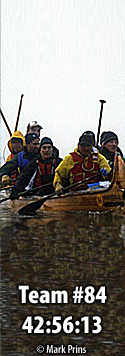
First Morning
At about 6 am we saw a power line. I remembered from the way points, that there was a power line just before Carmacks. I said something about this and everyone got excited. Martin looked at the GPS and said we were no where near Carmacks. Damn. Wrong power line.
Just before 8 am we started getting close to Carmacks. Everyone got more energy and our paddling picked up. We were flying when we came into Carmacks. I was thinking it would be better if we could just continue. I was pretty sure I was too wound up to sleep. We crossed the end line and pulled into the dock. There were lots of volunteers to help grab the canoe and help people out of the canoe. I got out and stood on the dock. I thought I could stand on my own since I had been standing up to cross over Ryan every couples of minutes. However my legs were weak, my balance was off and the dock was rocking. I almost fell down and a volunteer steadied me. I got off the dock but the ground kept swaying.
We had arrived in 20 hours and were in second place overall, but 2 hours behind the leaders. People on shore told us we were the talk of the race. Everyone was amazed that a voyageur team could do this well.
Ron was there and had set up our tents. Martin immediately went to his tent to sleep. He looked absolutely beat; paddling in the stern was the toughest job by far. The camp ground had showers and a washer and dryer. Because so few racers were there, the showers were available and so was the dryer. I took a shower to warm up and then put my clothes in the dryer. Ron got the clothes out of the dryer for us later.
I went back to our tents and had something to eat. Ron had made stew with caribou sausage. It hit the spot. Then I went into the tent and got in my sleeping bag. I put in ear plugs and an eye covering and tried to sleep. Just as I was afraid of – no chance. I could hear my heart beat and I started counting it. Damn it. It took a lot of mental effort to keep counting strokes and I just couldn't turn it off. I lay there for 4 or 5 hours and maybe slept a few minutes.
I got up about 2 pm, an hour before we were to leave. I had some more to eat; Ryan had some Pringle chips and they hit the spot. The idea of eating a power bar made me gag. I did cut up some more apples and took another couple of bagel sandwiches. The day was quite nice – I think about 15 degrees C. I put on 2 quick dry shirts on top but left off my Goretex jacket.
Ron had dried our clothes and they were all mixed together in the van. Lots of our team were wearing the shirts the race committee had given out; they were very nice quick dry shirts. Martin took the last one out of the van and put it on. He exclaimed “This shirt stinks. This isn't my stink. Gaaah.” We hadn't washed the shirts, just dried them. I think Martin ended up with Ken's shirt and it smelled of Ken.
Everyone was up by 2:30 and most people said they felt pretty good. Ryan said the inside of his elbow was hurting. Ron told him this was caused by straining his bicep. I pointed out to Ryan that with the marathon stroke you don't pull on the paddle and you shouldn't be using your bicep. Ryan thought you were supposed to pull a little bit. Its pretty tough to learn the marathon stroke in the midst of over 40 hours of paddling.
Myself, I felt worse than I had when we arrived. My left wrist had seized up. When you do the marathon stroke your cock your bottom wrist to get as much angle forward on the stroke as you can. The stress of this had really buggered my wrist. We had no proper wraps so I wrapped it in duct take - for the first wrap I put with the sticky part out so I wouldn't have to tear out all the hair to take it off.
We were slow getting into the canoe and were 10 minutes late getting away. It seemed to me that the guys from up north were slow getting going.
So away we went again. When we started paddling my left wrist was killing me. When I cocked it to stroke on my left side, it really hurt. When I used it to pull myself across the canoe in a switch, it also hurt like hell. If it kept getting worse I would soon be paddling only on one side.
We started at a reasonable stroke rate. I couldn't paddle hard at first; my body was all stiff. As we paddled it started to loosen up.
After about 5 hours we reached Five Finger Rapids. The river was split into 5 channels as it went through some pretty neat looking rocks. You were supposed to take the channel on river right and we did. It was a class 2 rapid – very easy in a big, voyageur canoe.
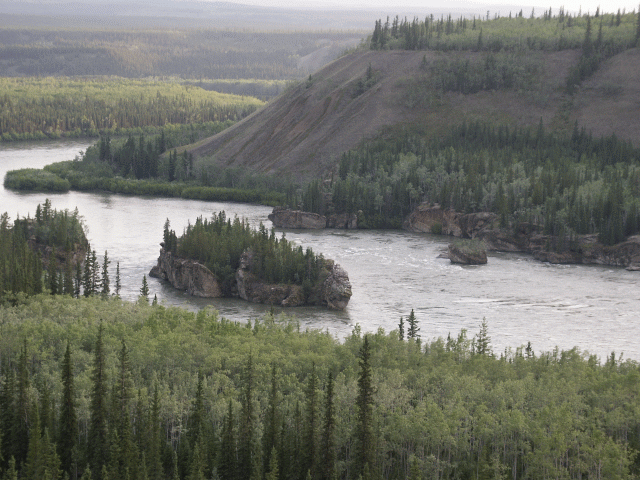
Five Finger Rapids
After a while the guys from up north decided to increase the paddling rate. At least thats what I think they were discussing, but, since they were speaking in Dene, its hard to know for sure. We jumped up to over 60 strokes per minute and held it there for over an hour. I was paddling pretty close to 100%. When we slowed down we dropped the rate to around 30 strokes per minute and stayed at the low rate for at least ½ hour. Then we jumped up again and then slowed down again. I protested and said that we should find a consistent stroke rate and stick to it. It felt to me like we were trying to run a marathon by sprinting and then walking. No one else really agreed with me, but we eventually stopped bouncing up and down and started paddling in the 50s.
When we were paddling hard (in the 50's and above) there wasn't a lot of talking. An hour could go by without anyone saying anything. Paul and Chris talked the most; they joked to each other in Dene.
The night didn't get dark and stayed pretty warm. I didn't stop to put on more clothes; I paddled all night with 2 shirts and a life jacket.
Again in the early hours of the morning, Ryan started to suffer again. He really wanted to know when we would get to Kirkman Creek, our next stop. I really had no idea. I guessed 10 am, but I don't remember where I got that number from. Ryan wasn't very happy with 10 am.
Just after 5 am, Martin announced that Kirkman Creek was about an hour away. That got everyone perked up and paddling harder. By this time my wrist was actually feeling quite a bit better. Some how it had loosened up. We got to Kirkman Creek at just after 6 am.
The lead team was just getting ready to leave when we arrived; they had maintained their 2 hour lead. We were still in second; we hadn't seen another boat since we left Carmacks.
When we got out of the canoe, I was freezing. I thought it was because I didn't have enough clothes on but later I was told that the same thing happens to people when they run a marathon. When you stop at the finish line, your body shuts down and you get very cold. I stood by a fire to warm up and then got soup and a sandwich. I then went to use the outhouse. There was only one so I went before the other teams arrived. I didn't want to be standing in line when we were trying to leave. Then I pulled off all my wet clothes, put them in the sun on the tent where everyone was sleeping (the race volunteers had set up a number of tents) and put on dry clothes. I went inside the tent; there was a tarp on the ground. I lay my sleeping bag on the tarp and got inside. I had forgot to bring in some clothes to use as a pillow and I didn't have enough energy to get some. Damn. It was hard to find a comfortable position but I managed to sleep for an hour. When I got up ½ hour before we left, I felt much better. Much better than I had after Carmacks.
We started getting in the canoe again after 9. Unfortunately we were late getting away again; we were about 5 minutes late. The guys from up north were slow and Ryan had to wait in line to use the outhouse.
We started paddling and almost immediately jumped up to max. Everyone was feeling pretty good and wanted to cut into the lead kayak's lead. We held max for about an hour. We blew by some casual canoeists like they were standing still. That was a close as we got to racing another team. I was so proud of our team I almost cried. Perhaps the lack of sleep was making me a bit wacky.
When we slowed down I was spent. I had just used up all the energy I had recovered at Kirkman Creek. We slowed for at least half an hour and then sprinted again. I couldn't paddle hard at that speed any more. We were going too fast for me to push hard on my paddle. Chris and Paul wanted us to go hard for an hour but after 45 minutes Gordon slowed. Even Gordon couldn't keep the pace up. We slowed quite a bit. Our paddling was getting pretty ragged. A few times someone would take a break, take some food and then pass it around. Soon everyone was passing food around and not paddling. Martin could see our speed drop on the GPS and would yell at us for someone to get paddling again. I think we got going again with our stroke rate in the high 40s, but there were a lot of breaks.
The river was quite mirky from the glacier till but it was still drinkable. We knew that after the White River joined, the water had so much till it was undrinkable so we filled all our water bottles before the White. Paul and, maybe, Gordon didn't like the water out of the river and decided not to drink it. It was quite sunny and hot and everyone was drinking quite a bit of water. Most people were dipping their hat in the water to cool themselves. Paul was soon getting kind of desperate. I had been saving a bottle that had been filled in Carmacks and, once I realized Paul was having water trouble, I gave it to him.
I continued to count to 50 and call switches. By this time I had counted to 50 over 2000 times. After the race it took me a day to turn off counting. I would still count steps when I was walking, bites when I was chewing, etc. Afterwards I joked with Martin that the incidence of autism is much higher than average in Silicon Valley. This has been blamed on the high number of software wienies (like me) in the area.
Martin remained in the stern. I was amazed he had spent all that time there since paddling in the stern is so much harder than any other position. A few times he asked us what channel we all thought we should take. One time there was a short cut that wouldn't be much of one if the river slowed going through it. We looked it over and it looked like lots of water was going through it so we all agreed to take the short cut. It worked out well. Near as I could tell Martin was picking good channels, but afterwards he said he thought he could of done a better job.
As the afternoon wore on, people started to struggle. Both Michael and Ryan we paddling with their eyes closed. When I noticed Ryan out of synchronization, which would happen since he wasn't watching Gordon, I would bark “Get in sync”. I was very sympathetic.
Ryan and I talked a bit about how to do the marathon stroke. I think Ryan had it pretty much figured out. I told him that during all these hours of paddling he should be working on his stroke. Given that he could hardly lift his arms and every stroke made him grimace in pain, he didn't think so.
We had all read about people hallucinating while coming into Dawson City. During the afternoon I noticed that if I looked at a rock wall I immediately saw cats and dogs and lions and whatever. I wasn't really hallucinating; it was more like when you stare at clouds for a few minutes and you start seeing things that you know they aren't real. In our state in sleep deprivation we saw them immediately. It was actually quite entertaining. You glance at a rock wall and you get a whole mural of, at least for me, animals: lions, cats, dogs, wolves. You know that aren't real but they still look neat. One stand of trees had letters all across them. I said I saw them and Ken said he did as well so they must have been fairly obvious. Afterwards Ken said that the images that he saw must have been there and would of been obvious to anyone. It was a funny comment coming from Ken who doesn't say much and is solid as the rock of Gibraltar. I'm not sure we convinced him otherwise.
Finally Martin announced we were within 20 km of Dawson City. Soon the torture of paddling would be over. I looked so forward to not having to pee while kneeling. Even more I was tired of switching (we had switched over 2000 times), especially going over Ryan. I grabbed the gunwale with my left hand, pulled, stood up to a crouch, shuffled my feet by Ryan's and then sat down making sure I didn't sit on Ryan's paddle (which happened a couple of times). I was having trouble grabbing the other gunwale and my legs had very little push. Ryan had developed the nasty habit of leaning forward when I did and blocking me from grabbing the gunwale. Our switches were getting slower and slower.
We thought the 20 km should take about an hour, but it was 20 km according to the GPS. It ended up taking closer to 2 hours. When we had less than 5 km to go we started to speed up. When we could finally see Dawson City we started to sprint. At the end we were sprinting at full speed. We crossed the finish line and the crowd was cheering. We only saw one other boat on the shore; we had finished second. Again I felt like crying, I was so proud of our team.
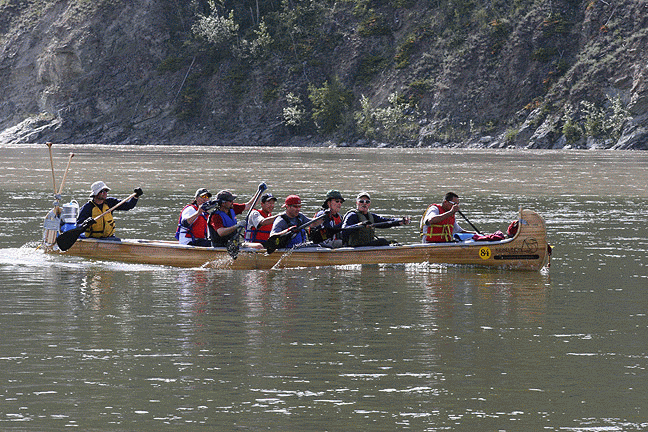
Coming into the finish line at Dawson City
We finished at 5:26 pm, which was second overall and first in the voyageur class in a time of just under 43 hours (42:56:13 to be exact). We broke the old voyageur record by 12 hours.
We got out of the canoe and on to shore. Lots of people congratulated us saying we were the talk of the race. It felt so good to be done. Lots of us got interviewed; Martin's comments were published in the Whitehorse newspaper. He said although we had a fast canoe, it was teamwork that got us into second place. He even mentioned that one guy counted strokes the whole way. Ryan was interviewed by CBC radio since he was first Yukoner to finish. He seemed somewhat embarrassed by this. It seemed to me he had certainly suffered as much as anyone so he should be proud of his achievement.
Below you can see Chris and Paul holding up the flag of Lac Brochet and Gordon being interviewed. Martin has a huge grin on his face.
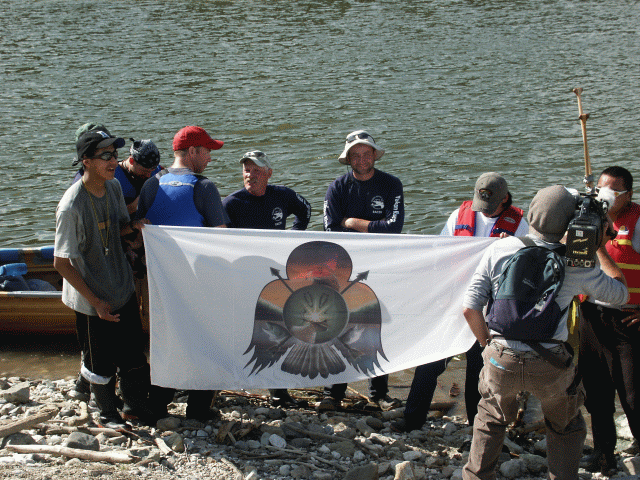
Being interviewed at the end of the race
We met Ron and we had to decide where to stay. We choose a camp ground across the river that turned out to be a good choice. There was a ferry that ran back and forth across the river 24 hours a day. Ken, Ryan, Michael, Ron and I went across and set up tents. We then went back into town to have a shower at the RV camp ground in town. Before having a shower I phoned my wife. I had tried to phone before but she wasn't home. She was very excited and proud of our finish. She had been following on the Internet. The first time she checked she couldn't find us. She went through all the teams and couldn't figure out what had happened to us. Then she checked the top few (which she had only glanced at before). There we were in second place. After the phone call I had a shower and put on fresh clothes. That felt so good. I even shaved.
The other guys phoned their wives and got heck for waiting for so long before they phoned.. Everyone had been following on the Internet and knew we had finished hours before.
As we were leaving the RV camp ground, Martin drove up in the van. His eyes looked so wild there was no way he should have been driving. He looked like he as completely whacked out on drugs. After a having a shower he went to bed. The rest of us stayed up waiting for the other teams to get in.
At the finish line, we found out about the other teams. Of the 70 teams that started, 19 had given up. Most gave up the first night when they got too cold and wet. The voyageur team we had passed at the beginning had given up that night because one of their team members had gone into hypothermia.
At about 7 or 8 pm a strong wind came through town and blew dust everywhere. It was a head wind for anyone who was still paddling. We heard from paddlers that came in later that the wind added a couple of hours to everyone's paddle. During the race we had talked about going hard so we got off the water as soon as possible to minimize the chance of something bad hitting us. It certainly worked out that way.
Ken and I watched other teams come in until we realized it was 10 pm and we hadn't gone for dinner yet. While walking around Whitehorse looking for somewhere to eat, we came across Brandon Nelson from the winning team and his wife Heather Nelson who finished 6th overall and was the fastest women kayaker ever. They congratulated us and we congratulated them. He said it was great that a voyageur team had finally been up among the leaders. When Brandon put out his hand for a hand shake, it was pretty shocking. He had huge hands to begin with and they looked swollen to double size plus he had a huge blister in his palm. We carefully shook his hand. Below is a picture of Brandon and David Kelly at the finish. They had finished over 2 hours ahead of us and had set a new course record of 40:37:05. Also below is the blister on Brandon's right hand taken also right at the finish. That looks so painful.
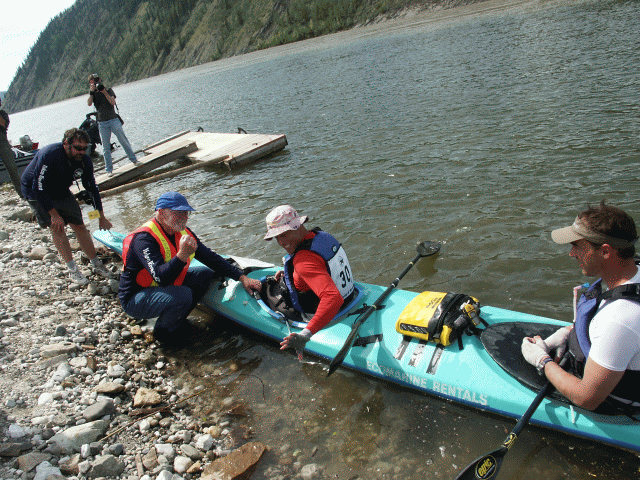
Winning Team at the Finish
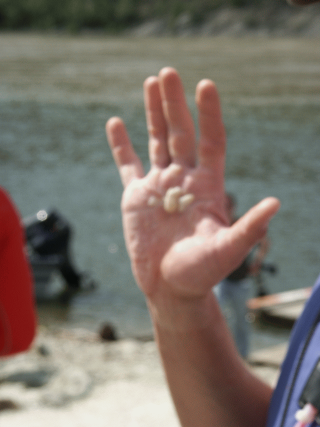
Brandon's Blister
Ken and I ended up eating burgers and pizza at Diamond Tooth Girteys. It was about the only place that was still serving food. Then we headed back to the river to watch more teams arrive.
The British team that had camped beside us in Whitehorse got in after midnight. One of them commented from my clothes that either we had scratched or finished a long time before. I told him we had finished second overall, but he really wasn't interested. He had just finished the longest, or at least one of the longest, races in the world and wanted to appreciate his own achievement and not think about someone else's. You couldn't blame him for that.
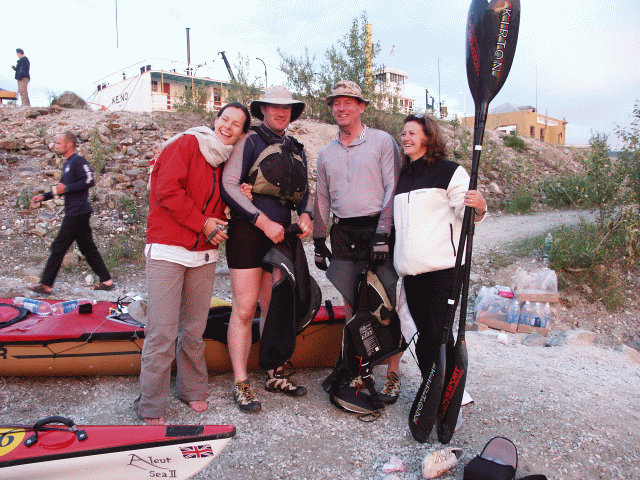
British Marines (Team 16) At the Finish
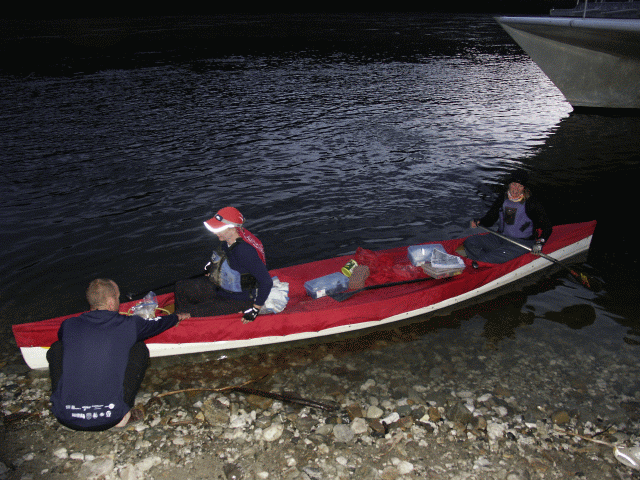
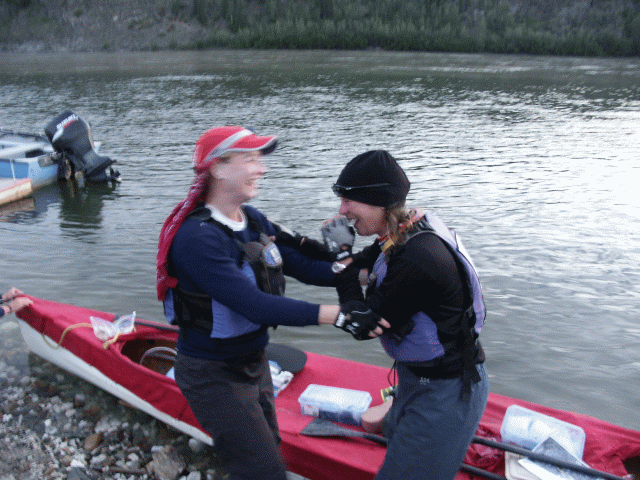
We spent Saturday wandering around Dawson City. It was hard to notice time going by because the intensity of the sun didn't change much. It was never all the strong and stayed the same even after 11 pm. In the afternoon Ron decided to do some massages. He had even brought his massage table. I jumped in first and it felt great. Next Michele got on the table. She groaned so much people wondered if something else was going on.
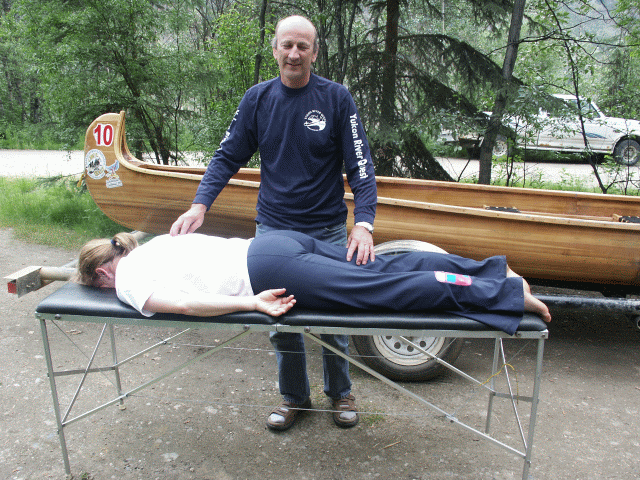
Michele gets a massage
While hanging around the finish line, I got into a conversation with Laurel and Dennis Fosseneuve (Dennis is from Cumberland House, Saskatchewan and had finished second in the tandem canoe open class) about the marathon stroke. Dennis talked about pushing down like you were pole vaulting. Laurel talked about using your core – during the stroke you show your back to a person observing from the side and then your front. Laurel said it takes a person 5 years of practice to get good enough at the stroke to be able to be a serious racer. I have so much to learn about marathon canoing although I feel good about my progress over the last 2 years. Laurel also described the poke which is used for steering a outrigger canoe.
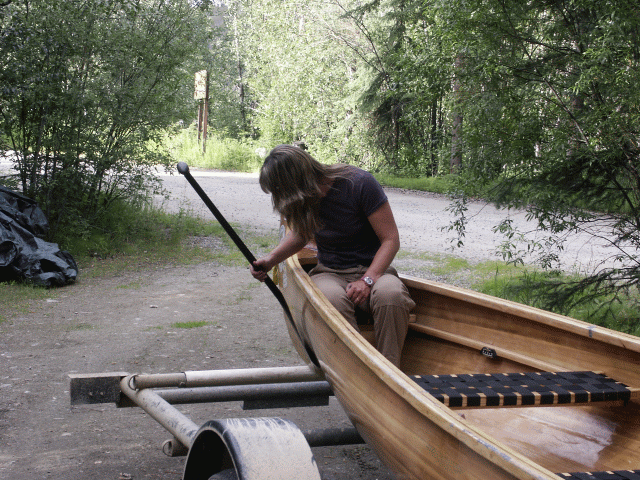
Laurel demonstrates the poke steering stroke
Sunday there was a banquet for all the racers. The last racer had finished at 3 am Sunday morning. My god that would have been a long time paddling. Ryan won a prize for being the first Yukoner to finish: he received a sleeve of beer cans. Our team won as the first voyageur team and received $1500 in prize money. Considering we spent $1600 in entry fee, a little more money would have been nice but I'm not really complaining. I told Martin he could keep my share since he had spent so much more than anyone else on the trip.
We found out at the banquet that
Katherine had been flown to Whitehorse because she had a blood clot in
her lung. She had managed to finish the race but could hardly breathe
afterwards. She was examined in Dawson City and then emergency air
lifted to Whitehorse. Everything turned out okay but the clot was
extremely dangerous - she could of easily died.
By 3 pm we were back on the road to Saskatoon. It took us 40 hours to get home – we wasted time waiting for a gas station to open (and then running out of gas just outside Fort St John because we hadn't purchased enough and then having to get gas from a heavy duty machinery company) and stopping twice for meals.
The whole adventure was 11 days long and we had stayed up all night for 5 of them: 1 on the drive up; 2 during the race and 2 during the drive home. Crazy.